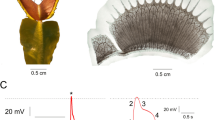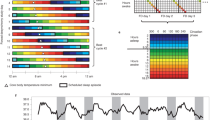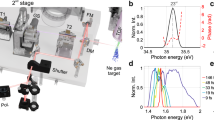Abstract
MANY physiological processes in plants and animals are rhythmic, that is, they undergo a 24 h sequence of change at the end of which the initial situation has been re-established. Furthermore, these rhythms almost always persist in the absence of temperature and light–dark cycles. These persistent rhythms are said to be timed by the organism's biological clock1.
This is a preview of subscription content, access via your institution
Access options
Subscribe to this journal
Receive 51 print issues and online access
$199.00 per year
only $3.90 per issue
Buy this article
- Purchase on Springer Link
- Instant access to full article PDF
Prices may be subject to local taxes which are calculated during checkout
Similar content being viewed by others
References
Palmer, J. D., in Encyclopedia of the Biological Sciences (edit. by Gray, P.), second ed. (in the press, 1969).
Bruce, V. G., Cold Spring Harbor Symp. Quant. Biol., 25, 29 (1960).
Sweeney, B. M., and Hasting, J. W., Cold Spring Harbor Symp. Quant Biol., 25, 87 (1960).
Gwinner, E., Experientia, 22, 765 (1966).
Menaker, M., and Eskin, A., Science, 154, 1579 (1966).
Lohmann, M., and Enright, J. T., Comp. Biochem. Physiol., 22, 289 (1967).
Meyer, A., Naturwissenschaften, 55, 234 (1968).
Enright, J. T., Science, 147, 864 (1965).
Wever, R., Z. Vergl. Physiol., 56, 111 (1959).
Palmer, J. D., Nature, 215, 64 (1967).
Aschoff, J., Ecology, 47, 657 (1966).
Edwards, D. K., Canad. J. Zool., 38, 900 (1960).
Brown, F. A., Biol. Bull., 123, 282 (1962).
Webb, H. M., Brown, F. A., and Brett, W. J., Biol. Bull., 117, 430 (1959).
Brown, F. A., in Circadian Clocks (edit. by Aschoff, J.), 231 (North-Holland Publ. Co., Amsterdam, 1965).
Tverskoi, P. V., Physics of the Atmosphere, NASA TTF-288 (published for the National Aeronautics and Space Administration, USA, and the National Sciences Foundation, Washington, DC, by the Israel Program for Scientific Translation, 1965).
Lutherer, L. I., Folk, G. E., and Essler, W. O., Amer. Zool., 2, 536 (1962).
Author information
Authors and Affiliations
Rights and permissions
About this article
Cite this article
DOWSE, H., PALMER, J. Entrainment of Circadian Activity Rhythms in Mice by Electrostatic Fields. Nature 222, 564–566 (1969). https://doi.org/10.1038/222564a0
Received:
Revised:
Issue Date:
DOI: https://doi.org/10.1038/222564a0
This article is cited by
-
Light, Reactive Oxygen Species, and Magnetic Fields Activating ERK/MAPK Signaling Pathway in Cultured Zebrafish Cells
Applied Magnetic Resonance (2012)
-
Biophysics of animal response to an electrostatic field
Journal of Biological Physics (1976)
-
The suppression of mouse spontaneous locomotor activity by the ingestion of deuterium oxide
Experientia (1976)
-
Stoffwechselphysiologische Auswirkungen der Faradayschen Abschirmung und eines künstlichen luftelektrischen Feldes der Frequenz 10 Hz auf weiße Mäuse
Archiv für Meteorologie, Geophysik und Bioklimatologie Serie B (1972)
-
ELF rotating magnetic fields: Prenatal exposure and adult behavior
Archiv für Meteorologie, Geophysik und Bioklimatologie Serie B (1970)
Comments
By submitting a comment you agree to abide by our Terms and Community Guidelines. If you find something abusive or that does not comply with our terms or guidelines please flag it as inappropriate.



